Makroökonomik
In der Abteilung Makroökonomik werden kurz- und mittelfristige Schwankungen gesamtwirtschaftlicher Variablen (zum Beispiel des Bruttoinlandsprodukts, der Beschäftigung, der Preise und der Zinsen), die Wirkungen wirtschaftspolitischer Maßnahmen auf diese Größen und die institutionellen Rahmenbedingungen für Konjunktur und langfristiges Wirtschaftswachstum erforscht. Auf Basis dieser Forschung bietet die Abteilung wissenschaftlich fundierte und evidenzbasierte wirtschaftspolitische Beratung an.
Die Abteilung deckt ein breites Spektrum makroökonomischer Fragestellungen ab. Die Forschungsschwerpunkte liegen in der Entwicklung, Implementierung und Anwendung quantitativer makroökonomischer Modelle sowie in der Analyse der Interaktion von Finanzsystem und realwirtschaftlicher Entwicklung.
Ihr Kontakt

- Abteilung Makroökonomik
Referierte Publikationen
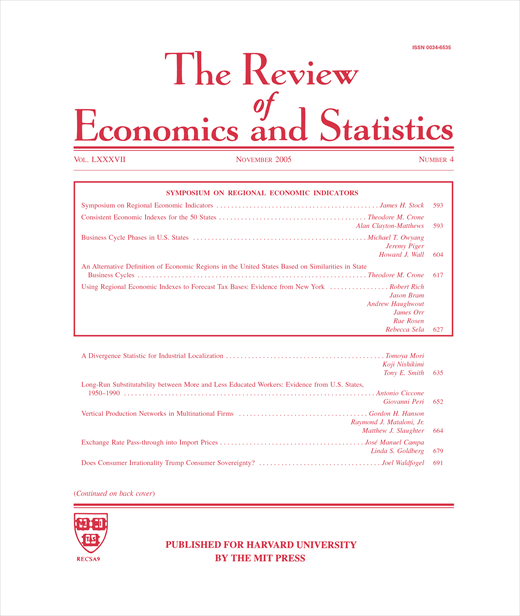
Sticky Prices or Sticky Wages? An Equivalence Result
in: Review of Economics and Statistics, im Erscheinen
Abstract
<p>We show an equivalence result in the standard representative agent New Keynesian model after demand, wage markup and correlated price markup and TFP shocks: assuming sticky prices and flexible wages yields identical allocations for GDP, consumption, labor, inflation and interest rates to the opposite case- flexible prices and sticky wages. This equivalence result arises if the price and wage Phillips curves' slopes are identical and generalizes to any pair of price and wage Phillips curve slopes such that their sum and product are identical. Nevertheless, the cyclical implications for profits and wages are substantially different. We discuss how the equivalence breaks when these factor-distributional implications matter for aggregate allocations, e.g. in New Keynesian models with heterogeneous agents, endogenous firm entry, and non-constant returns to scale in production. Lastly, we point to an econometric identification problem raised by our equivalence result and discuss possible solutions thereof.</p>

Transparency and Forecasting: The Impact of Conditioning Assumptions on Forecast Accuracy
in: Applied Economic Letters, im Erscheinen
Abstract
<p>This study investigates the impact of inaccurate assumptions on economic forecast precision. We construct a new dataset comprising an unbalanced panel of annual German GDP forecasts from various institutions, taking into account their underlying assumptions. We explicitly control for different forecast horizons to reflect the information available at the time of release. Our analysis reveals that approximately 75% of the variation in squared forecast errors can be attributed to the variation in squared errors of the initial assumptions. This finding emphasizes the importance of accurate assumptions in economic forecasting and suggests that forecasters should transparently disclose their assumptions to enhance the usefulness of their forecasts in shaping effective policy recommendations.</p>

Step by Step ‒ A Quarterly Evaluation of EU Commission's GDP Forecasts
in: Journal of Forecasting, im Erscheinen
Abstract
<p>The European Commission’s growth forecasts play a crucial role in shaping policies and provide a benchmark for many (national) forecasters. The annual forecasts are built on quarterly estimates, which do not receive much attention and are hardly known. Therefore, this paper provides a comprehensive analysis of multi-period ahead quarterly GDP growth forecasts for the European Union (EU), euro area, and several EU member states with respect to first-release and current-release data. Forecast revisions and forecast errors are analyzed, and the results show that the forecasts are not systematically biased. However, GDP forecasts for several member states tend to be overestimated at short-time horizons. Furthermore, the final forecast revision in the current quarter is generally downward biased for almost all countries. Overall, the differences in mean forecast errors are minor when using real-time data or pseudo-real-time data and these differences do not significantly impact the overall assessment of the forecasts’ quality. Additionally, the forecast performance varies across countries, with smaller countries and Central and Eastern European countries (CEECs) experiencing larger forecast errors. The paper provides evidence that there is still potential for improvement in forecasting techniques both for nowcasts but also forecasts up to eight quarters ahead. In the latter case, the performance of the mean forecast tends to be superior for many countries.</p>
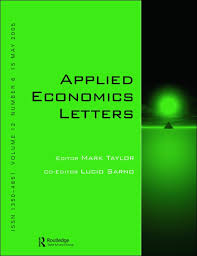
The Effects of the Iberian Exception Mechanism on Wholesale Electricity Prices and Consumer Inflation: A Synthetic-controls Approach
in: Applied Economic Letters, im Erscheinen
Abstract
<p>This study employs synthetic control methods to estimate the effect of the Iberian exception mechanism on wholesale electricity prices and consumer inflation, for both Spain and Portugal. We find that the intervention led to an average reduction of approximately 40% in the spot price of electricity between July 2022 and June 2023 in both Spain and Portugal. Regarding overall inflation, we observe notable differences between the two countries. In Spain, the intervention has an immediate effect, and results in an average decrease of 3.5 percentage points over the twelve months under consideration. In Portugal, however, the impact is small and generally close to zero. Different electricity market structures in each country are a plausible explanation.</p>

A Multi-Model Assessment of Inequality and Climate Change
in: Nature Climate Change, October 2024
Abstract
<p>Climate change and inequality are critical and interrelated defining issues for this century. Despite growing empirical evidence on the economic incidence of climate policies and impacts, mainstream model-based assessments are often silent on the interplay between climate change and economic inequality. For example, all the major model comparisons reviewed in IPCC neglect within-country inequalities. Here we fill this gap by presenting a model ensemble of eight large-scale Integrated Assessment Models belonging to different model paradigms and featuring economic heterogeneity. We study the distributional implications of Paris-aligned climate target of 1.5 degree and include different carbon revenue redistribution schemes. Moreover, we account for the economic inequalities resulting from residual and avoided climate impacts. We find that price-based climate policies without compensatory measures increase economic inequality in most countries and across models. However, revenue redistribution through equal per-capita transfers can offset this effect, leading to on average decrease in the Gini index by almost two points. When climate benefits are included, inequality is further reduced, but only in the long term. Around mid-century, the combination of dried-up carbon revenues and yet limited climate benefits leads to higher inequality under the Paris target than in the Reference scenario, indicating the need for further policy measures in the medium term.</p>
Arbeitspapiere
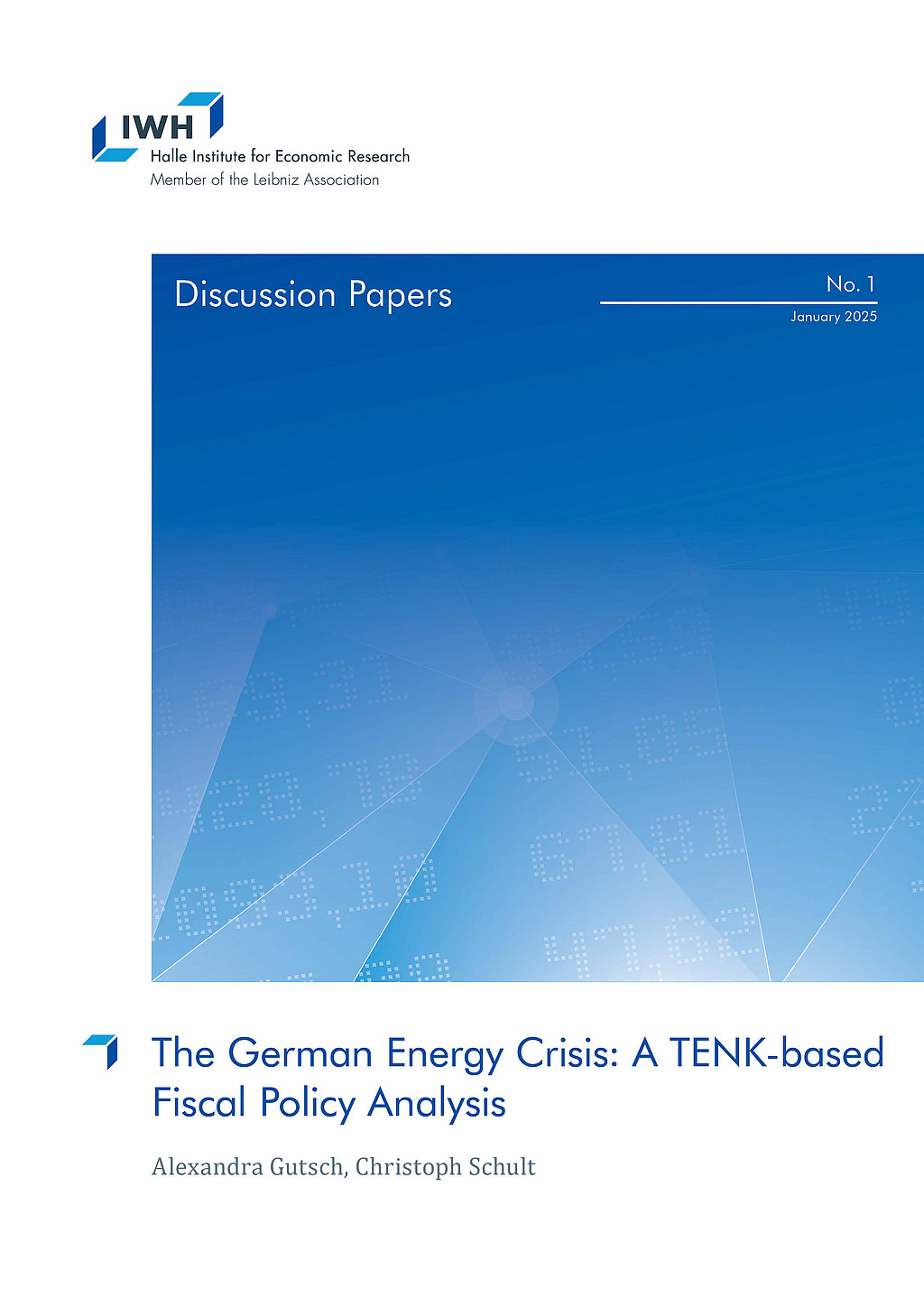
The German Energy Crisis: A TENK-based Fiscal Policy Analysis
in: IWH Discussion Papers, Nr. 1, 2025
Abstract
<p>We study the aggregate, distributional, and welfare effects of fiscal policy responses to Germany’s energy crisis using a novel Ten-Agents New-Keynesian (TENK) model. The energy crisis, compounded by the COVID-19 pandemic, led to sharp increases in energy prices, inflation, and significant consumption disparities across households. Our model, calibrated to Germany’s income and consumption distribution, evaluates key policy interventions, including untargeted and targeted transfers, a value-added tax cut, energy tax reductions, and an energy cost brake. We find that untargeted transfers had the largest short-term aggregate impact, while targeted transfers were most cost-effective in supporting lower-income households. Other instruments, as the prominent energy cost brake, yielded comparably limited welfare gains. These results highlight the importance of targeted fiscal measures in addressing distributional effects and stabilizing consumption during economic crises.</p>
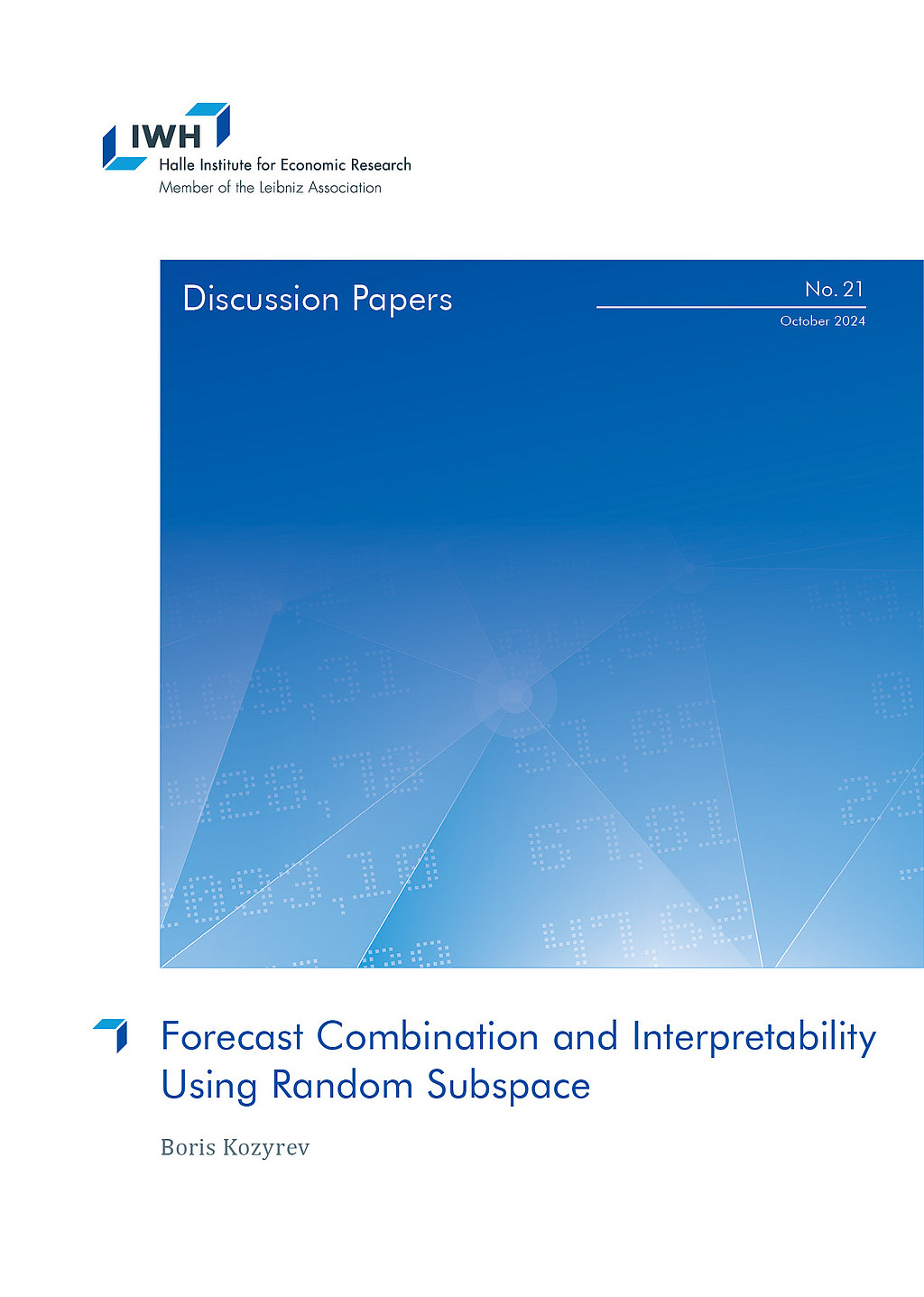
Forecast Combination and Interpretability Using Random Subspace
in: IWH Discussion Papers, Nr. 21, 2024
Abstract
<p>This paper investigates forecast aggregation via the random subspace regressions method (RSM) and explores the potential link between RSM and the Shapley value decomposition (SVD) using the US GDP growth rates. This technique combination enables handling high-dimensional data and reveals the relative importance of each individual forecast. First, it is possible to enhance forecasting performance in certain practical instances by randomly selecting smaller subsets of individual forecasts and obtaining a new set of predictions based on a regression-based weighting scheme. The optimal value of selected individual forecasts is also empirically studied. Then, a connection between RSM and SVD is proposed, enabling the examination of each individual forecast’s contribution to the final prediction, even when there is a large number of forecasts. This approach is model-agnostic (can be applied to any set of predictions) and facilitates understanding of how the aggregated prediction is obtained based on individual forecasts, which is crucial for decision-makers.</p>

Climate Policy and International Capital Reallocation
in: IWH Discussion Papers, Nr. 20, 2024
Abstract
<p>This study employs bilateral data on external assets to examine the impact of climate policies on the reallocation of international capital. We find that the stringency of climate policy in the destination country is significantly and positively associated with an increase in the allocation of portfolio equity and banking investment to that country. However, it does not show significant effects on the allocation of foreign direct investment and portfolio debt. Our findings are not driven by valuation effects, and we present evidence that suggests diversification, suasion, and uncertainty mitigation as possible underlying mechanisms.</p>
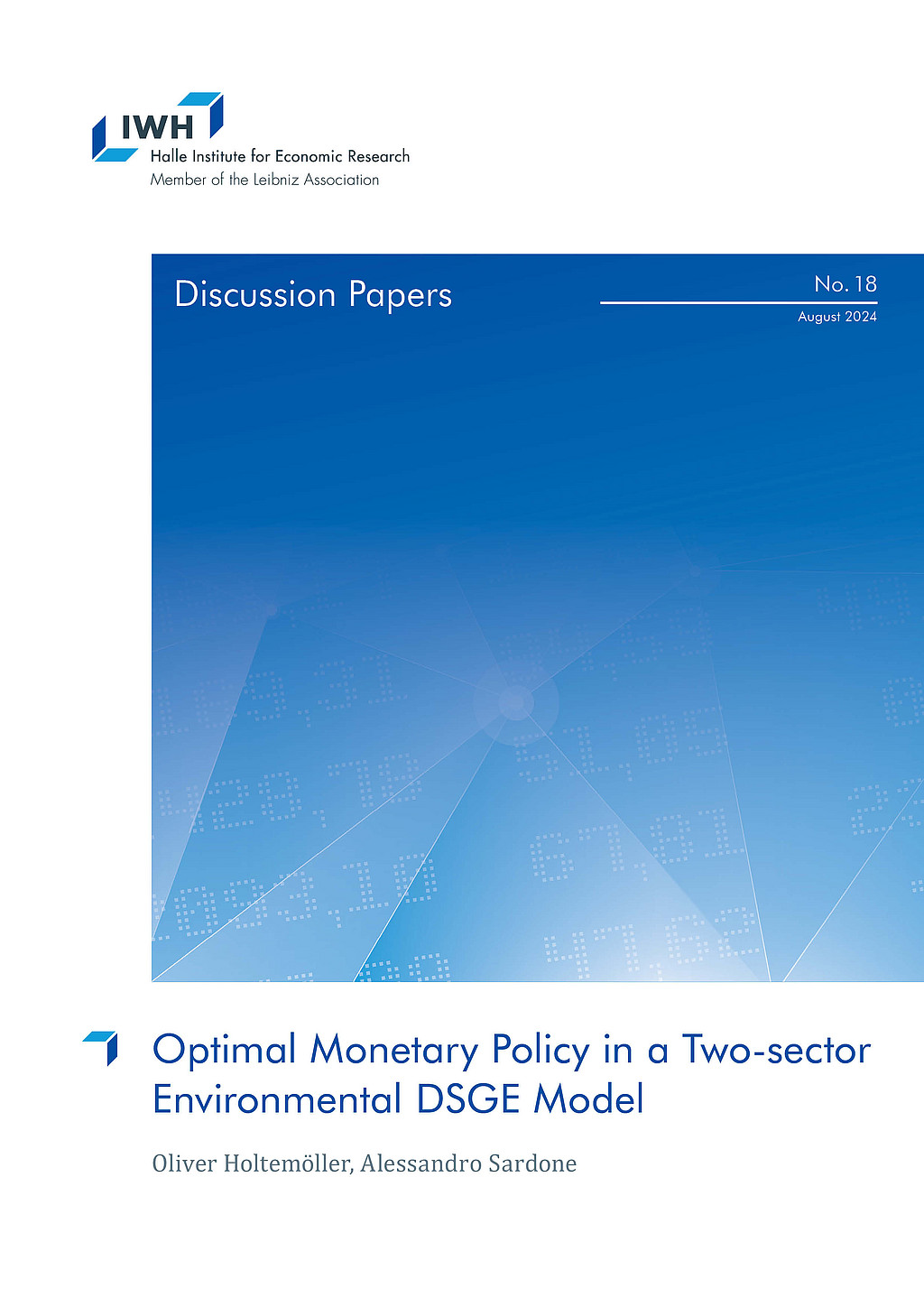
Optimal Monetary Policy in a Two-sector Environmental DSGE Model
in: IWH Discussion Papers, Nr. 18, 2024
Abstract
<p>In this paper, we discuss how environmental damage and emission reduction policies affect the conduct of monetary policy in a two-sector (clean and dirty) dynamic stochastic general equilibrium model. In particular, we examine the optimal response of the interest rate to changes in sectoral inflation due to standard supply shocks, conditional on a given environmental policy. We then compare the performance of a nonstandard monetary rule with sectoral inflation targets to that of a standard Taylor rule. Our main results are as follows: first, the optimal monetary policy is affected by the existence of environmental policy (carbon taxation), as this introduces a distortion in the relative price level between the clean and dirty sectors. Second, compared with a standard Taylor rule targeting aggregate inflation, a monetary policy rule with asymmetric responses to sector-specific inflation allows for reduced volatility in the inflation gap, output gap, and emissions. Third, a nonstandard monetary policy rule allows for a higher level of welfare, so the two goals of welfare maximization and emission minimization can be aligned.</p>

Risky Oil: It's All in the Tails
in: NBER Working Paper, Nr. 32524, 2024
Abstract
<p>The substantial fluctuations in oil prices in the wake of the COVID-19 pandemic and the Russian invasion of Ukraine have highlighted the importance of tail events in the global market for crude oil which call for careful risk assessment. In this paper we focus on forecasting tail risks in the oil market by setting up a general empirical framework that allows for flexible predictive distributions of oil prices that can depart from normality. This model, based on Bayesian additive regression trees, remains agnostic on the functional form of the conditional mean relations and assumes that the shocks are driven by a stochastic volatility model. We show that our nonparametric approach improves in terms of tail forecasts upon three competing models: quantile regressions commonly used for studying tail events, the Bayesian VAR with stochastic volatility, and the simple random walk. We illustrate the practical relevance of our new approach by tracking the evolution of predictive densities during three recent economic and geopolitical crisis episodes, by developing consumer and producer distress indices that signal the build-up of upside and downside price risk, and by conducting a risk scenario analysis for 2024.</p>

































